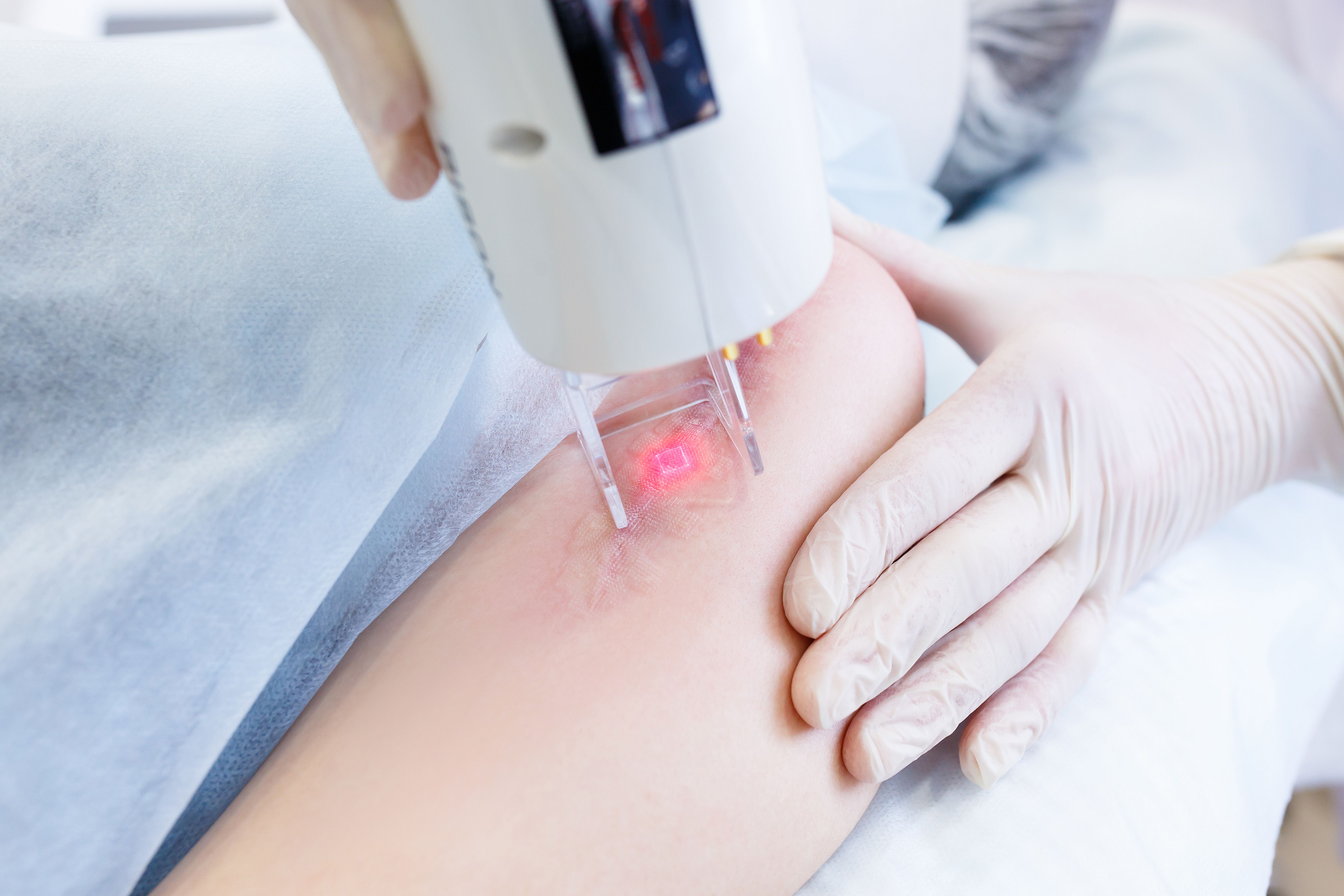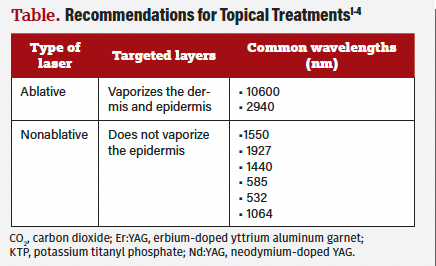- Case-Based Roundtable
- General Dermatology
- Eczema
- Chronic Hand Eczema
- Alopecia
- Aesthetics
- Vitiligo
- COVID-19
- Actinic Keratosis
- Precision Medicine and Biologics
- Rare Disease
- Wound Care
- Rosacea
- Psoriasis
- Psoriatic Arthritis
- Atopic Dermatitis
- Melasma
- NP and PA
- Skin Cancer
- Hidradenitis Suppurativa
- Drug Watch
- Pigmentary Disorders
- Acne
- Pediatric Dermatology
- Practice Management
- Prurigo Nodularis
- Buy-and-Bill
News
Article
Dermatology Times
Nonablative Lasers Offer a Gentle Approach to Healthy Skin
In honor of National Healthy Skin Month, it is the perfect time to encourage patients to integrate gentle laser treatments into their yearly routine to maintain healthy, radiant skin.
4frame group/Adobe Stock

In honor of National Healthy Skin Month, it is the perfect time to encourage patients to integrate gentle laser treatments into their yearly routine to maintain healthy, radiant skin.
In recent years, laser technology has undergone significant advancements, expanding the range of available lasers for various applications. Lasers are specifically designed to target different tissue types—with water, hemoglobin, and pigment being the most common chromophores.1
Lasers come in 2 categories: ablative and nonablative. Ablative lasers vaporize tissue at the level of the epidermis in a fractionated or fully ablative manner, which is a very effective technique for skin rejuvenation; however, increased downtime, infection risk, and persistent erythema are all potential adverse effects.
Nonablative lasers deliver less thermal injury and promote dermal wound healing while protecting the stratum corneum through precise penetrating waves and cooling mechanisms.2 This process, known as photothermolysis, generates heat at the dermal level, stimulating collagen and elastin production and, in some cases, scar remodeling.1,3 Nonablative fractional lasers (NAFLs) achieve this by using thousands of tiny, deep columns to deliver precise heat levels.4
Nonablative lasers can also have specific targets, such as hemoglobin and pigment. Many of these devices are used to treat redness, photoaging, and unwanted tattoos with minimal downtime due to preservation of the skin barrier.2,5 See the Table1,2 for a comparison of both types of lasers.

Improving Skin Cancer
Skin cancer is the most prevalent cancer in the United States and that more than 3 million Americans are diagnosed with nonmelanoma skin cancers each year.6 Repeated exposure increases the risk of developing nonmelanoma skin cancers, such as basal cell carcinoma and squamous cell carcinoma. These 2 types of cancer are collectively known as keratinocyte carcinoma (KC).
In individuals with a history of prior KC, the risk of developing subsequent KC remains a significant concern. This risk is particularly pronounced in the 5 years following the initial diagnosis. For instance, within 3 years post diagnosis, there is a 35% probability of developing another KC, and this risk escalates to as much as 50% within a 5-year period. Factors that contribute to an increased risk of KC include being male, being older than 60 years, having a history of multiple previous skin cancers, and having substantial actinic skin damage or skin that is prone to sunburn.7
According to the American Society for Dermatologic Surgery, even precancerous skin lesions such as actinic keratosis and actinic cheilitis have the ability to transform into squamous cell carcinoma.8 There is, however, good news for those who already have sun-damaged skin and are looking to improve the overall health of their skin. A recent retrospective study conducted at the Massachusetts General Hospital Dermatology Laser and Cosmetic Center in Boston found that in patients treated with NAFLs for facial KCs, only 20.9% subsequently developed a KC, whereas the control group had a 40.4% rate of subsequent KC development. After accounting for age, gender, and skin type, individuals in the control group had a higher likelihood of developing new facial KC compared with patients who underwent laser treatment.9
Improving Photoaging Damage
In 2014, a study in the Journal of Cosmetic and Laser Therapy examined a group of 10 female participants. These individuals, ranging in age from 35 to 53 years and with skin types I to IV, exhibited mild to moderate facial photodamage. This photodamage was characterized by various features, including hyperpigmentation, telangiectasia, skin laxity, skin roughness, and actinic keratosis. These individuals underwent a series of treatments using a nonablative fractional Q-switched 1064-nm Nd:YAG laser. The therapeutic regimen included 4 sessions spaced at 2- to 4-week intervals, with follow-up assessments at 1 and 3 months after the final treatment session.
Baseline assessments using the Glogau scale revealed that 6 participants were classified as type II (indicating wrinkles in motion), and 4 participants were designated as type III (indicating wrinkles at rest). Impressively, at the 3-month follow-up after the final session, 60% of participants exhibited a notable 1-point or greater enhancement in their overall Glogau scale score. Moreover, it was observed during the study that the laser treatments resulted in substantial improvements in various skin irregularities: Hyperpigmentation decreased by 70%, telangiectasias by 80%, laxity by 80%, tactile roughness by 60%, and actinic keratoses by 60%. The investigators concluded that the nonablative fractional Q-switched 1064-nm Nd:YAG laser demonstrated both safety and efficacy in ameliorating mild to moderate photodamage with minimal downtime and discomfort and without any discernible adverse effects.10
In a 2021 study published in the same journal, researchers investigated the safety and effectiveness of a 1565-nm NAFL for addressing facial photoaging. Patients underwent 3 NAFL treatment sessions (1 month apart) on 1 side of their face, and then the treated side was compared with the untreated side between sessions. The results showed significant improvements in facial skin laxity, wrinkles, and pores as well as reduced sagging of the nasolabial groove on the NAFL-treated side compared with the untreated side (baseline). Additionally, the study compared NAFL with microneedle fractional radiofrequency (MFR) and found similar outcomes for MFR-treated skin but that NAFL offered a more convenient treatment option due to its shorter downtime.11
In Summary
Nonablative lasers have emerged as a gentle yet highly effective approach to achieving healthier skin. They utilize precise photothermolysis to stimulate collagen and elastin production and promote dermal wound healing with minimal downtime. These lasers can reduce the development of KC and improve the overall health of sun-damaged skin. NAFLs have also demonstrated remarkable success in ameliorating photodamage and improving hyperpigmentation, telangiectasias, skin laxity, and tactile roughness.
In conclusion, nonablative lasers represent a promising solution for individuals seeking healthier and more youthful-looking skin with fewer associated risks and downtime.
Nina Ventura is a doctor of osteopathic medicine candidate and a master of health services administration candidate at Lake Erie College of Osteopathic Medicine in Elmira, New York.
Mara C. Weinstein Velez, MD, FAAD, is a board-certified dermatologist and the director of cosmetic and laser dermatology at University of Rochester Medical School in New York.
References
- Prohaska J, Hohman MH. Laser complications. In: StatPearls Treasure Island (FL): StatPearls Publishing; 2023 Jan https://www.ncbi.nlm.nih.gov/books/NBK532248/
- Madan V. Practical Introduction to Laser Dermatology. Springer Cham; 2020. doi:10.1007/978-3-030-46451-6
- Khamees EJ, Jawad NN, Azeez HM. The use of lasers (ablative laser, non-ablative laser, fractional laser, photobiomodulation (PBM)) in skin regeneration. IJBPCS. 2022;4(1):7-13. doi:10.32996/ijbpcs.2022.4.1.2
- Non-ablative laser rejuvenation. American Society for Dermatologic Surgery. Accessed October 7, 2023. https://www.asds.net/skin-experts/skin-treatments/non-ablative-laser-rejuvenation
- Non-ablative skin rejuvenation for sun-damaged skin. American Society for Dermatologic Surgery. Accessed October 7, 2023. https://www.asds.net/skin-experts/skin-treatments/non-ablative-skin-rejuvenation-for-sun-damaged-skin
- Skin cancer incidence rates. American Academy of Dermatology Association. Updated April 22, 2022. Accessed October 9, 2023. https://www.aad.org/media/stats-skin-cancer
- Karagas MR, Stukel TA, Greenberg ER, Baron JA, Mott LA, Stern RS. Risk of subsequent basal cell carcinoma and squamous cell carcinoma of the skin among patients with prior skin cancer. Skin Cancer Prevention Study. JAMA. 1992;267(24):3305-3310. doi:10.1001/JAMA.1992.03480240067036
- Sun-damaged skin. American Society for Dermatologic Surgery. Accessed October 20, 2023. https://www.asds.net/skin-experts/skin-conditions/sun-damaged-skin
- Benson TA, Hibler BP, Kotliar D, Avram M. Nonablative fractional laser treatment is associated with a decreased risk of subsequent facial keratinocyte carcinoma development. Dermatol Surg. 2023;49(2):149-154. doi:10.1097/DSS.0000000000003672
- Gold MH, Sensing W, Biron J. Fractional Q-switched 1,064-nm laser for the treatment of photoaged-photodamaged skin. J Cosmet Laser Ther. 2014;16(2):69-76. doi:10.3109/14764172.2013.864197
- Dou W, Yang Q, Yin Y, et al. Fractional microneedle radiofrequency device and fractional erbium-doped glass 1,565-nm device treatment of human facial photoaging: a prospective, split-face, random clinical trial. J Cosmet Laser Ther. 2021;23(5-6):142-148. doi:10.1080/14764172.2022.2033783






